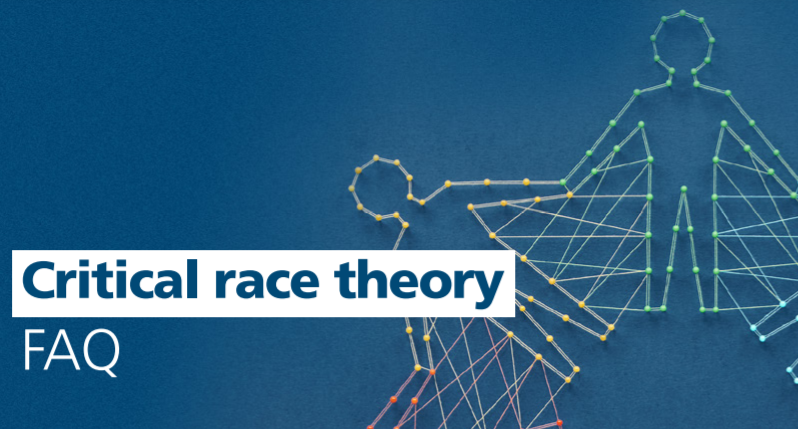Once an obscure academic concept, the term critical race theory (CRT) has become a regular fixture in mainstream media and social media as well as local school board meetings. Many California school board trustees have asked CSBA for information on critical race theory to help guide these discussions. This document is intended to provide the requested support; it is not an advocacy piece making the case for or against CRT; that is a local matter. The purpose of this document is to provide additional background on CRT in order to allow for more productive conversations about this subject, and to distinguish it from other initiatives that may or may not be related. More than 20 state legislatures have introduced legislation to ban critical race theory from classrooms, and parents, staff and community members nationwide are seeking information on, offering support for or expressing criticism of CRT.
What is critical race theory?
CRT is a practice of interrogating race and racism in society and the ways in which it impacts people. CRT emphasizes race as a social construct (a classification system developed by society that can change over time, rather than fixed biological categories) with social significance, not a biological reality. It acknowledges that racism is embedded within systems and institutions that replicate racial inequality — codified in law, embedded in structures, and woven into public policy. The concept that came to be known as CRT was developed by Harvard Law School Professor Derrick Bell in the mid-1970s as Critical Legal Studies and refined by other legal scholars such as Kimberlé Crenshaw (who coined the term critical race theory), Neil Gotanda, Gary Peller and Kendall Thomas. CRT has since spread to other fields, as it is closer to a method of analysis than a fixed academic subject, and thus evolves along with the society it critiques.
Is CRT synonymous with diversity, equity or inclusion?
Some critics of CRT have mistaken or mislabeled any discussion of equity, diversity or ethnic studies as equivalent to CRT. Although certain approach–es to ethnic studies may incorporate elements of CRT — as these concepts are both concerned with how race is constructed and the political, historical, social and cultural effects of race and ethnicity — they are not synonymous or interchangeable. Ethnic studies predates CRT and began in the 1960s as an attempt to correct the lack of access, misrepresentation and neglect of indigenous peoples and people of color through better representation of the experiences, contributions, culture, art and politics of groups whose stories where typically overlooked or underplayed in the curriculum. As typically taught in K-12 schools today, ethnic studies aims to build greater appreciation, under–standing and respect between students of different backgrounds.
What are the main principles of CRT?
1) Race is a social construct, not a biological reality. Since race is a social construct, people’s experiences related to race are impacted by the systems and policies that society designs. Historically, racial categories were created to justify and maintain social hierarchies, group-based exploitation and disparate levels of rights, access and privileges.
2) Racial categories are created at various points to serve a range of groups and purposes, so racial definitions differ across place and time and shift according to societal needs.
3) As a social construct, race is tied to other social constructions intended to bestow advantages on certain groups, such as (but not exclusive to) groups of people identified by their race, class, gender, sexuality, ethnicity or nationality.
4) Discrimination should be understood not in terms of discrete, individual actions but as the product of systems and institutions where racism may be embedded and replicated.
5) Because race was integral to the development of American systems and institutions like law, government, nationhood, politics, religion and the economy, those institutions — whether by accident or design — retain aspects of the racial preferences that influenced their development.
6) Inequity results partly from the legacy of the racial attitudes and social goals of the originators at the time the systems were developed since legislation or judicial decisions outlawing explicit discrimination often fail to address the racialized nature of the underlying structures and policies of systems and institutions.
7) Without a structural analysis of the way in which race is used to reinforce social, political and economic power, solutions that emphasize colorblindness, integration and avoidance of prejudice and stereotyping are inadequate. To the extent that these frames overlook the impact of systemic racism, they preserve the status quo and enable discriminatory practices that are harmful to people of color.
8) Major changes that benefit people of color typically occur when an oppressive policy conflicts with one of the larger goals of American society (e.g., individual freedom, freedom of association, free markets, property rights, domestic or international interests) and creates alignment between the interests of people of color and American institutions.
9) People who have been oppressed have a unique perspective to offer on their circumstances. The everyday lives and experiences of people of color are relevant to scholarship and should be included in research on issues of race and efforts to combat racial discrimination.
10) CRT should be used not only to understand but also to challenge, reform and dismantle systems of power that perpetuate discrimination.
How does CRT relate to education?
In 1995, the scholars Gloria Ladson-Billings and William F. Tate began applying the principles of CRT to the field of education as a way to understand inequities within the education system. CRT argues that legal interventions, while helpful and essential to the cause of eradicating discriminatory aspects of the education system, are not by themselves sufficient to promote equality in schools. For example, merely ending legal segregation did not appropriately address de facto racism nor the systemic impact of factors like housing, demographic patterns, and funding mechanisms and decisions.
Scholars who have applied CRT to education have identified examples of racial inequality in schools such as:
- Ongoing segregation within and across school districts
- Ongoing segregation within schools
- Inadequate resources and facilities in predominantly African American and Latino school districts
- Disproportionate discipline of African American and other groups of students
- Narrow assessments that provide inaccurate measures of student ability and achievement
- Barriers to advanced classes, gifted programs and selective schools
- Curriculum that neglects the contributions and experiences of non-dominant groups
In essence, researchers who use CRT to study education evaluate how certain practices can contribute to racial inequality and seek and advocate for potential solutions.
Does CRT say that all white people are racist?
No. CRT avoids a focus on the individual in favor of critiquing how systems use race to allocate social, political and economic power in ways that favor certain groups, historically white people in the case of the United States. Critical Race Theory holds that racism is embedded in American systems and institutions and part of everyday life, so people can perpetuate and benefit from racism through their normal, everyday existence, even if they do so unintentionally. The goal is not to create guilt, but instead to examine the source and impact of racial inequality and advocate for change.
Is CRT Marxist?
CRT was developed by left-leaning legal scholars, some of whom were neo-Marxist, but it is not inherently Marxist. Marxism is too complex to explain appropriately here, but in simple terms, it can be understood as the idea that history and society are driven by struggle between the ruling and oppressed classes. Marx believed that the relationship between the capitalist class and the working class is inherently exploitative and bound for conflict, which will ultimately result in substitution of collective ownership for private ownership and the dissolution of social classes and class struggle.
There is significant tension between CRT scholars and those who ground their cultural analysis in the Marxist tradition of class struggle. While some scholars see Marxism as potentially compatible with critical race theory, others criticize the emphasis that CRT puts on race as opposed to economic class or other factors. Other scholars critique CRT for potentially alienating the white working class from people of color who hold similar class status.
Is CRT widespread in K-12 public schools?
No. There is no evidence that CRT is widespread in K-12 education. Although there is no definitive resource documenting the prevalence of CRT in schools, the consensus is that CRT is not included in curriculum and is rarely taught in K-12 schools. While often confused, CRT is not synonymous with culturally relevant teaching or pedagogy, which aims to nurture:
- Student learning: By supporting students’ intellectual growth, moral development and ability to reason and problem-solve
- Cultural competence: By encouraging students to affirm and appreciate their culture of origin while developing fluency in at least one other culture
- Critical consciousness: By improving students’ ability to identify, analyze and solve real-world problems, especially those that result in societal inequalities
CRT should also not be confused with ethnic studies, which is designed to highlight the often-overlooked history, experiences and cultures of underrepresented groups, and to build respect and appreciation between students of different backgrounds.
What does state law say about the CRT and ethnic studies?
The state law that required the development of the Ethnic Studies Model Curriculum does not mandate or recommend the incorporation of specific concepts into a course that an LEA may choose to offer to its students. Education Code states, in part, that:
- The Instructional Quality Commission shall develop, and the state board shall adopt, modify or revise, a model curriculum in ethnic studies to ensure quality courses of study in ethnic studies. The model curriculum shall be developed with participation from faculty of ethnic studies programs at universities and colleges with ethnic studies programs and a group of representatives of local educational agencies, a majority of whom are kindergarten to grade 12, inclusive, teachers who have relevant experience or education background in the study and teaching of ethnic studies. (EC 51226.7 (a))
- The model curriculum shall be written as a guide to allow school districts to adapt their courses to reflect the pupil demographics in their communities. The model curriculum shall include examples of courses offered by local educational agencies that have been approved as meeting the A–G admissions requirements of the University of California and the California State University, including, to the extent possible, course outlines for those courses. (EC 51226.7 (b))
- Beginning in the school year following the adoption of the model curriculum pursuant to this section, each school district or charter school maintaining any of grades 9 to 12, inclusive, that does not otherwise offer a standards-based ethnic studies curriculum is encouraged to offer to all otherwise qualified pupils a course of study in ethnic studies based on the model curriculum. A school district or charter school that elects to offer a course of study in ethnic studies pursuant to this subdivision shall offer the course as an elective in the social sciences or English language arts and shall make the course available in at least one year during a pupil’s enrollment in grades 9 to 12, inclusive. (EC 51226.7 (e))
How is CRT related to California’s Ethnic Studies Model Curriculum?
The state’s model curriculum is intended to provide guidance to school districts and county offices of education. It does not require specific concepts — such as critical race theory — be incorporated, should an LEA decide to offer an ethnic studies course. In fact, the only references to CRT in the model curriculum are outlined below:
In Chapter 3, “Instructional Guidance for K-12 Education,” under “Useful Theory, Pedagogy, and Research” in the Approaches to Ethnic Studies section, the model curriculum recommends that teachers and administrators should “familiarize themselves with current scholarly research around ethnic studies instruction, such as critically and culturally/community relevant and responsible pedagogies, critical race theory, and intersectionality, which are key theoretical frameworks and pedagogies that can be used in ethnic studies research and instruction.”
The Ethnic Studies Model Curriculum also provides a footnote linking to a definition of CRT outlined within “A Lesson on Critical Race Theory.” The definition states that “Critical race theory (CRT) is a practice of interrogating race and racism in society. CRT recognizes that race is not biologically real but is socially constructed and socially significant. It acknowledges that racism is embedded within systems and institutions that replicate racial inequality — codified in law, embedded in structures, and woven into public policy” (George, 2021).
The Chapter 6 Overview notes: The course outlines provided with this model curriculum are intended to offer guidance to teachers and administrators interested in developing courses/units in ethnic studies. Every course is unique, and LEAs are encouraged to tailor their particular courses to the needs and interests of their student population.
Questions or comments? Contact csba@csba.org.
Portions of this document





